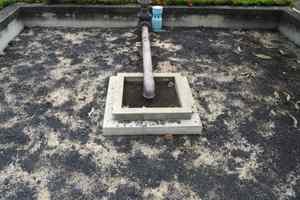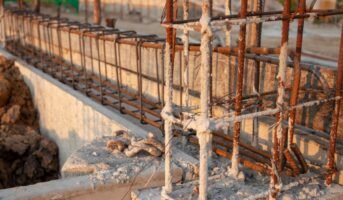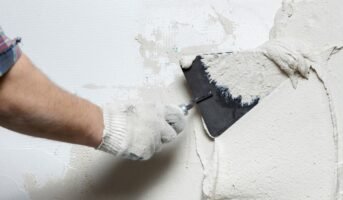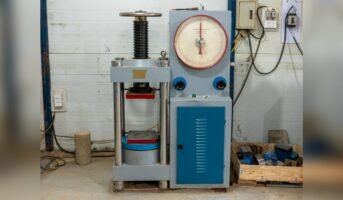A grit chamber is a long, narrow, or circular tank that is part of the primary sewage treatment plant. Its purpose is to slow down the flow of sewage in order to remove grit materials, which include sand, ash and clinkers, eggshells, bone chips, and many other inorganic elements.
Grit chamber: Composition of grit
In addition to not being able to putrefy, the hydraulic subsidence value of grit is significantly larger than that of organic materials. The typical range for the grit’s specific gravity is between 2.4 and 2.65. The following factors influenced the grit’s composition in different ways:
- The various types of street surfaces that might be found.
- Relative locations that are being served.
- Climatic conditions.
- Various configurations of inlets and catch basins.
- Amount of rainwater that is redirected away from combined sewers and into overflow points sewer grades.
- The construction of the sewage system, as well as its current state.
- The features of the ground and groundwater.
- Wastes from industry and social customs also contribute.
Uses of grit chamber
Following are some of the major uses of grit chambers as sewage treatment plants.
- Grit chambers are used to prevent equipment from clogging.
- They are used to slow down the flow with the objective of settling heavy solids.
- A grit chamber is used for saving the waste treatment cost.
- It is also used to control grit collection in sludge digesters.
Types of grit chambers?
There are three primary categories that are used to categorise grit chambers.
- Long grit channels with a regulated velocity and a V-shape
- Square-shaped chambers with entrances and exits on opposite sides, a mild hopper in the shape of a vortex cone, and
- Centrifugal motion that deposits grit at the bottom of the chambers.
In addition, depending on a number of factors, such as the quantity and quality of the grit that needs to be processed, the requirements for head loss, the space requirements, the topography, and the economic considerations with regard to both capital and operating costs, grit processing can be broken down into the following categories:
- Purified by means of a machine
- Cleansing done by hand
It’s possible that mechanisation won’t be cost-effective for relatively small facilities. When the flow rate at the sewage treatment plant is more than 10 MLD, the use of mechanical grit removal devices is recommended.
Vortex-type grit chamber
In this particular variety of grit chambers, the sewage is supplied in a tangential direction in order to generate a vortex-like flow. This form of flow will lead the grit towards the chamber’s centre, and it will then be sucked down to the bottom chamber. The grit is kept suspended in the liquid with the help of an agitator.
Grit has a heavier specific gravity of 2.4 to 2.65 and settles down as a result of a flow pattern that is characterised as a vortex. This grit is eventually emptied into a grit filter bed by gravity or pumped into the beds. The use of this device is beneficial in circumstances characterised by a wide range of sewage flow rates and durations.
Aerated grit chamber
It is a specialised type of grit chamber that consists of a tank with air-diffusion tubes fitted on one side of the tank and a spiral-flow aeration that flows through the tank. The sewage is made to flow in a helical pattern when it enters the grit chamber due to the design of the chamber as well as the air within the chamber.
The lighter organic particles are transported along with a roll of the spiral motion and are finally expelled from the tank, while the heavier grit particles are dragged down due to the helical flow pattern that is present.
Horizontal flow grit chambers
Horizontal flow grit chambers are a lean open channel with a length of around 10-18 metres and depth of 1-1.3 metre. Velocity in these chambers should be set such that it carries most organic particles through the chamber, re-suspending any that are designed. This controlled velocity will allow the weightier grit materials to settle. It’s advisable to keep a velocity of 0.3 m/s.
In addition to these three types of grit chambers, a grit chamber is further classified into two types, depending on the cleaning mechanism.
Mechanically cleaned
Mechanically cleaned grit chambers come with mechanical equipment that accumulates and washes grit chambers, serving on either intermittent or continuous basis.
Manually Cleaned
Manually run grit chambers are equipped with adequate capacity to hold the grits between the time of cleaning.
Grit chamber: Manual sifting and clearing of the grit
The manual clearing of the grit should be avoided unless it is necessary for extremely tiny STPs with a capacity of less than 1 MLD. In these cases, the operator of the STP can clean velocity-regulated channels manually by using a shovel and walking on a platform along the length of the channel.
Elimination of dirt and sand
After being removed from the chamber, grit is typically cleansed, with the exception of situations in which it may include a significant quantity of organic materials that results in an unpleasant odour. The most common methods for getting rid of them are dumping and using sanitary landfills. The method of disposal is chosen based on the physical and chemical properties of the grit, as well as the quality of the grit, the availability of land for disposal, and other factors.
Grit chamber: The functioning principle of a grit chamber
- The grit chambers perform the function of a sedimentation tank and are meant to separate the heavier inorganic materials (with a specific gravity of around 2.65) while allowing the lighter organic materials to move on to the next stage.
- The chamber is designed to maintain differential sedimentation and differential scouring velocity.
- This ensures that the flow velocity is not too low, which would result in the settling of lighter organic matter, nor is it too high, which would prevent the settlement of the silt and grit that is present in the sewage.
- Both of these conditions must be met for the chamber to function properly.
- The scouring velocity of grit particles should always be lower than the critical velocity of flow, denoted as VC, beyond which particles of a specific size and density eventually settle.
- The formula used by Schield to determine the critical velocity of scour reads as follows:
V equals 3.5 to 4.5 (g(Ss – 1)d)/0.5
- At peak flows, the horizontal velocity of flow is measured at 15 to 30 centimetres per second.
- To guarantee that only organic materials and not the grit are scoured from the bottom, it is imperative that this velocity be kept constant regardless of the variation in flow that may occur.
Advantages of grit chamber
- The purpose of this is to prevent abnormal wear and abrasion on moving mechanical equipment in order to cut down on the amount of money spent on maintenance and the number of times a digester needs to be cleaned because of an excessive accumulation of grit.
- In order to stop the accumulation of heavy deposits in the pipes and channels, a grit chamber is used.
Disadvantages of grit chamber
- Hazardous odours and unstable organic compounds are more likely to be discharged by them.
- Aeration system control and maintenance will require additional human resources.
- Compared to other methods of grit elimination, these methods consume more energy.
FAQs
Grit chambers process solid waste, but what happens to it?
Solid wastes are removed from wastewater by grit chambers, which are settling tanks.
What is the purpose of grit removal?
By removing grit, you prevent unnecessary abrasion and wear of mechanical equipment, grit buildup in pipelines and channels, in anaerobic digesters and aeration basins.
Housing News Desk is the news desk of leading online real estate portal, Housing.com. Housing News Desk focuses on a variety of topics such as real estate laws, taxes, current news, property trends, home loans, rentals, décor, green homes, home improvement, etc. The main objective of the news desk, is to cover the real estate sector from the perspective of providing information that is useful to the end-user.
Facebook: https://www.facebook.com/housing.com/
Twitter: https://twitter.com/Housing
Email: editor@housing.com











